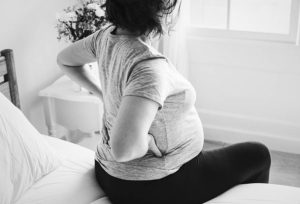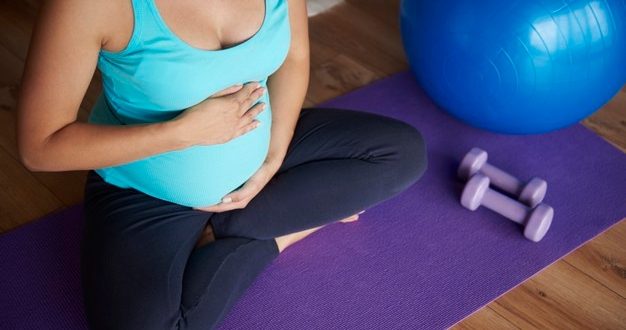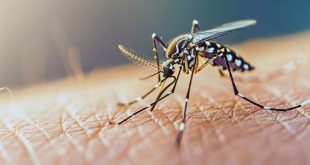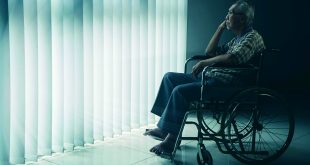
Bringing a baby into the world is supposed to be one of the most amazing experiences in a woman’s life. To have made through the journey of pregnancy, to hold your baby in your arms, is a triumphant moment for any mother. A healthy new bundle of joy in your life, what more could one possibly ask for? However, for all new mothers, one phase of the journey to motherhood may have ended with a beautiful new addition to the family, but another phase has just begun. A phase that is very rewarding, but equally demanding. Sometimes, instead of enjoying their time with the new baby to the fullest, the new mothers suffer from a nagging postpartum (after giving birth) back pain; so, along with nurturing a newborn, they are also nursing this persistent pain that just won’t go away.
Various researches have shown that about 60-70% of women experience back pain during pregnancy, and almost one third of those women report having the pain even after the delivery. Postpartum back pain usually increases with activities, and may be relieved a little with rest. Stiffness and soreness even after rest are also common occurrences in many women. For some, even regular and simple day-to-day activities that involve little body movements, such as turning in or getting up from bed, walking, lifting, bending, or carrying the baby may trigger the pain. Women may suffer from either lumbar/lumbosacral pain (lower back pain) or thoracic pain (upper back pain) or both. Back and pelvic pain during pregnancy may subside once the baby is born in a number of cases, but that does not always happen for all of the women. In some cases, it progressively gets worse.
There are various reasons for back pain during and after pregnancy. The cause of pregnancy-related back pain can be due to a combination of physiological, postural, hormonal, mechanical, and psychological factors. The major reason being: the pregnancy hormones causing changes in the musculoskeletal system. During pregnancy, a surge in the hormone called Relaxin relaxes our muscles and loosens our ligaments and joints in preparation for childbirth. This enables the pelvis to expand during birth by increasing the laxity in the ligaments around the pelvis. The release of these hormones causes changes that occur in the spine, as well. To maintain stability and provide support, the lower back region is connected and held by various ligaments, and supported by back muscles, pelvic floor muscles, and abdominal muscles. As a result of the hormonal changes, all these are affected, which in turn has an effect on the stability of the spine, leading to low back pain. As a result of decrease in the tone of the muscles and loosened ligaments, our joints become vulnerable to injuries. After delivery, the levels of these hormones decline gradually, allowing the joints to return to their original state. However, the changes persist even after the delivery and take an average of 6 to 8 weeks for the joints and surrounding tissues to stabilize and get back to their previous state and for the joints to bear weight effectively. While changes that begin during pregnancy resolve in some women, others develop a chronic condition and suffer from persistent symptoms lasting anywhere from a few weeks to over a decade.
Other causes include weakened and stretched abdominal muscles. During pregnancy, the abdominal muscles stretch to accommodate the growing baby. This results in the forward shift in the gravity and weakness in the core abdominal muscles. The growing belly also causes the back to arch more than usual, a condition termed hyperlordosis, thus causing persistent over-stretching and weakening of the back muscles, and putting mechanical stress on the facet joints and the intervertebral discs. This consistent stress may cause inflammation, making the situation worse. The weakness in both these groups of muscles (abdominal and back muscles), which work in harmony to maintain postural stability and ergonomics, causes poor posture and back pain. In some cases, the stretched abdominal muscles separate to cause a condition called ‘diastasis recti’, further weakening the abdominal muscles. The birth process itself, whether natural of surgical, may cause low back pain in many women. Strenuous and difficult labor during vaginal delivery causes strain and over exertion of joints and muscles in the pelvic and surrounding area. Sometimes, the muscles in the pelvic floor are injured during this process. Disuse, weakness of abdominal muscles due to surgical pain, and scar tissue adhesion may cause back pain in caesarian section delivery. Other causes include gaining excessive weight during pregnancy, which puts excessive load on the intervertebral discs, ligaments, and joints of the spine. Excessive load on the hips, knee, and ankle joints, resulting in pain in these joints, may also cause bad posture resulting in back pain. A sedentary lifestyle before and during pregnancy are other causes of back pain, where already inactive and weak muscles when put under pressure further weaken. Improper bending techniques while lifting the baby up, hunching during breast feeding, and improper ways of carrying your baby may also contribute to postpartum back pain.
What steps can we take to get rid of the pregnancy-related back pain? Back pain is a common prenatal and postnatal pregnancy concern, but physical therapy may be the answer to your problems. The first step is to talk to your gynecologist, who will evaluate you to see if you have any medical issues that is causing back pain. If the pain is very severe, a visit to an orthopedic doctor helps rule out more serious pregnancy-related conditions that need medical attention.
As a healthcare professional, who has had pregnancy-related back pain patients coming in, I noticed a third of the referred patients do not make it to the Department of Physical Therapy and Rehabilitation. The number one reason being the fact that physical therapy is considered to be just exercise-related, and exercise during and after pregnancy is something people believe they should not do. A qualified physical therapist who has experience in women’s health can help you during and after pregnancy by assessing you and devising customized plans that fits your specific needs. They create a set of safe exercise routines to strengthen back, abdominal, and pelvic floor muscles. They teach balance and stability exercises to improve body mechanics. They teach you proper techniques on how to pick, hold, feed, and change the baby without hurting your back. They give advice on proper ways of performing everyday activities like bending, lifting, and reaching, so the strain on our muscles and ligaments is not too much. They educate you on correct posture and teach you posture-improving exercises. As your muscles strengthen and your body recovers, they introduce mobility exercises and aerobic exercises (aerobic exercise could be as simple as brisk walking) so you may go back to being active. They help you gradually get back to the normal activities you were doing pre-pregnancy. They provide you with a complete guideline on how to get your life back together.
What are some of the steps we can take on our own to prevent and get rid of back pain?
1. It is important to remain active during the pregnancy. Taking walks, mild stretching, and strengthening exercises (unless advised against it by your doctor) help our bodies recover faster post partum.
2. When our muscles are strong, they can better handle the strain pregnancy puts on them. Eating nutritious food rich in protein, vitamins, calcium, and iron, and eating carbohydrate-rich food in moderation not only ensures proper nutrition for the growing fetus and the mothers themselves, but also helps mothers maintain healthy body weight.
3. After the baby is born, take the time you need to heal and recover. The concept of ‘me-time’ is an important one. At this time, the baby is the most important thing in your life, but taking some time out for yourself to relax and rest is equally important from both the physical and psychological perspective. Getting massages is a great way of relaxation.
4. Introduction to activities must be gradual, starting with the easier ones first. Wear ‘patuka’ or a post partum wrap belt to help support the lumbar and abdominal region for at least a month or two.
5. Once you feel more recovered, walking, mild strengthening exercises need to be started.
6. Always try to maintain healthy posture to keep aches and pains at bay. Do not hunch while feeding the baby. Use nursing or regular pillows instead. Bend from the hip and knees, when picking baby or objects to prevent back strains. Avoid using low beds or sofas for lesser stress on the spine, knee and hip joints. Turn to the side to get up from bed to avoid sudden jerky movement.
The key is to take care of ourselves since the planning stage of being pregnant. Maintaining a healthy and active lifestyle ensures a smoother journey on the road to motherhood.
 Medicosnext
Medicosnext



